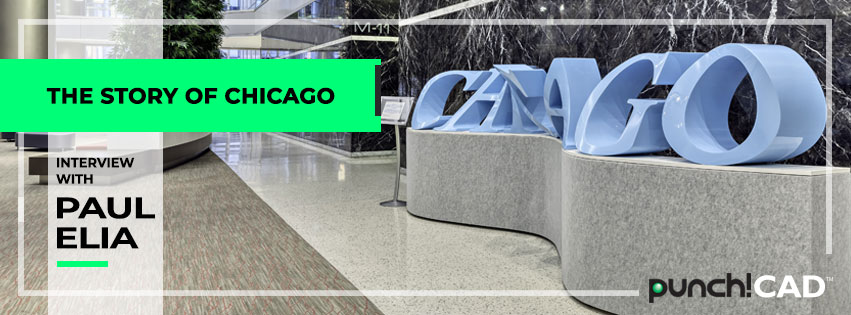The Story of ‘CHICAGO’ by Paul Elia

Tell us a little about who you are, your background and experience creating CHICAGO?
My name is Paul Elia and I am a sculptor living in Toronto. I attended the OCAD University where I was taught an earlier version of ViaCad. It was ViaCAD’s founder Tim Olson’s and PunchCad’s background in aerospace design (it’s toolbox of splines and curves) that I realized that I could use PunchCAD to transfer my sculptural designs directly from imagination to reality.
I have made sculptures in bronze and glass and began working on my “City” series but on a much larger scale. ‘CHICAGO’ is one of those in the series. Each of my sculptures has a theme and CHICAGO was one that I was having difficulty in ‘solving’. What would it look like, what would it represent? As had happened before, I appeared to solve the mystery in my sleep. I woke up with an idea and my moving hands told the story. This was the birth of the concept for CHICAGO: a flowing sculpture where nature’s wind moved the letters forward and back.
Moreover, while wind had an influence on Chicago, I realized that water had a big impact on Chicago’s trade and commerce. Water would now become the second theme of the sculpture.
Looking for the right color blue to represent it was easier than expected. It was discovered on the city’s official flag! There you will see two light blue bars representing Lake Michigan, the Chicago River and the Grand Canal. The flag is seen everywhere in the city – even on every policeman’s sleeve!
How did PunchCAD help you in designing ‘CHICAGO’?
I prefer to design my own fonts and did that using ViaCad’s’ splines and lines. I then made surfaces from them and then extruded the surfaces into solid letters.
I next used splines to make surfaces that I would use to ‘split’ each solid letter to create the movement I desired. What I really appreciated was the ‘associativity’ feature in Shark and ViaCad. By simply moving a point on a spline forward or back, the whole sculpture would change shape.
When the design was completed, the files were exported to the IGES format and Styrofoam was then carved using a CNC mill. In my studio, the letters were each coated in carbon fiber and then delivered to a body shop to be painted.
What is a piece of advice you’d like to impart on an aspiring designer?
My sense is that aspiring designers may have a tendency to begin the design process by sitting in front of a screen. That is great, but there is a subtle switching back and forth between left and right brain functions.
I would like to offer my take which is to start with a pencil and pad and just have fun sketching their ideas to start. Developing that muscle memory of hand to brain work will help in the future.
It was that training of moving my hands that gave me the shape for CHICAGO.
August 1, 2019
|
View: 2811





